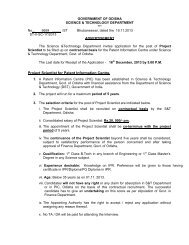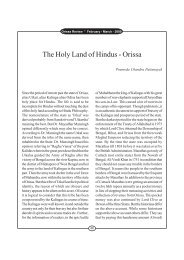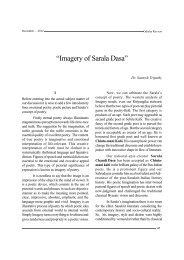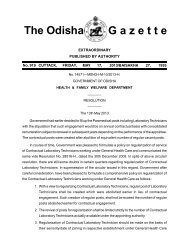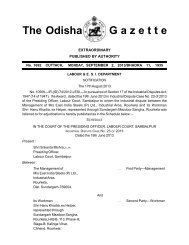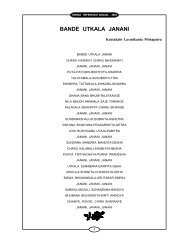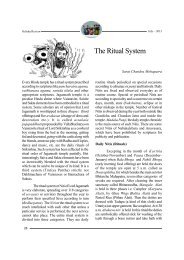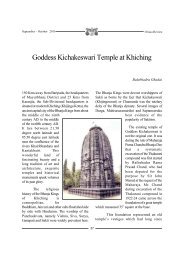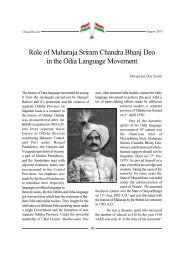The Cult of Saktism in Orissa - Government of Orissa
The Cult of Saktism in Orissa - Government of Orissa
The Cult of Saktism in Orissa - Government of Orissa
Create successful ePaper yourself
Turn your PDF publications into a flip-book with our unique Google optimized e-Paper software.
Ramachandi :<br />
<strong>The</strong> temple <strong>of</strong> Ramachandi is located on<br />
a sand dune near the mouths <strong>of</strong> the rivers<br />
Kushabhadra and Dhanua, four miles away on<br />
the sea-side from Konark, <strong>in</strong> an isolated place.<br />
Previously the temple was not negotiable by any<br />
road with only sands and shrubs around but now<br />
a pucca road leads to the temple from Konark<br />
and Puri. <strong>The</strong> place is famous for picnic for the<br />
natural beauties around and cool breeze <strong>of</strong> the<br />
sea.<br />
<strong>The</strong> boat shaped ro<strong>of</strong> <strong>of</strong> the entrance hall<br />
<strong>of</strong> the temple is the only shelter for the people<br />
com<strong>in</strong>g over, for picnic or prostration to goddess<br />
Mother, <strong>in</strong> ra<strong>in</strong> and Sun. Mahisha Mard<strong>in</strong>i Durga<br />
Ramachandi sits <strong>in</strong> the temple fac<strong>in</strong>g North. Sri<br />
Krupas<strong>in</strong>dhu Mishra, the historian has described<br />
<strong>in</strong> his book 'Konark' that orig<strong>in</strong>ally Ramachandi<br />
was worshipped <strong>in</strong> South - West corner <strong>of</strong> the<br />
court-yard <strong>of</strong> Konark temple and later shifted to<br />
the present shr<strong>in</strong>e. This has been admitted by<br />
Pandit Nilakantha Das although Adikabi Sarala<br />
Das and Balaram Das differ <strong>in</strong> their op<strong>in</strong>ion.<br />
Banaparva <strong>of</strong> Sarala Mahabharatand<br />
Aranyak Parba <strong>of</strong> Jagamohan Ramayan speak<br />
<strong>of</strong> Lord Ramachandra's prostration to goddess<br />
Ramachandi before <strong>in</strong>vasion <strong>of</strong> Lanka.<br />
<strong>The</strong> deity outside the Western wall is <strong>of</strong><br />
archeological importance. Two and half feet high,<br />
three faced and eight armed goddess stands on a<br />
chariot driven by seven horses. In four arms she<br />
carries goad, noose, bow and arrow and other<br />
four arms are broken. <strong>The</strong> skilled art <strong>of</strong> Konark<br />
temple is reflected <strong>in</strong> this deity flanked by Ganesh<br />
and Barahas.<br />
Charchika :<br />
<strong>The</strong> temple <strong>of</strong> goddess Charchika is<br />
situated on a mounta<strong>in</strong> at Banki town <strong>of</strong> Cuttack<br />
district, by the side <strong>of</strong> the river Mahanadi and<br />
associated with Lord Parashuram who had long<br />
<strong>Orissa</strong> Review September - 2009<br />
35<br />
meditation before goddess Charchika to get rid<br />
<strong>of</strong> the s<strong>in</strong> <strong>of</strong> matricide. So the place is known as<br />
Parashuram pitha. A river named Renuka (the<br />
name <strong>of</strong> the mother <strong>of</strong> Parashuram) was flow<strong>in</strong>g<br />
by the side <strong>of</strong> the mounta<strong>in</strong> <strong>in</strong> the long past. One<br />
<strong>of</strong> the k<strong>in</strong>gs <strong>of</strong> Dhala dynasty had constructed<br />
this temple. Though the ma<strong>in</strong> temple is<br />
architecturally <strong>of</strong> no attraction, its front wooden<br />
pavilion preserves <strong>Orissa</strong>n antique art and<br />
architecture <strong>in</strong> wooden carv<strong>in</strong>g. <strong>The</strong> thickets<br />
encircl<strong>in</strong>g the temple have been replaced by a<br />
small town.<br />
<strong>The</strong> presid<strong>in</strong>g deity fixed to the back wall<br />
<strong>of</strong> sanctum - sanctorum has withered and a replica<br />
is kept <strong>in</strong> the central niche <strong>of</strong> the outer Southern<br />
wall <strong>of</strong> the ma<strong>in</strong> shr<strong>in</strong>e which may be well identified<br />
with a Chamunda stand<strong>in</strong>g on a dead body, fully<br />
undressed, with a garland <strong>of</strong> skull around her<br />
neck. Goddess Charchika with her eight hands<br />
displays sword, trident, snake, goad, garland <strong>of</strong><br />
beads, boon, damaru (small double faced drum)<br />
and severed head etc. Goddess Charchika does<br />
not come under goddess <strong>of</strong> Vaishnavism. She is<br />
Chamunda, for which non-vegetarian food is<br />
<strong>of</strong>fered daily. From iconographic and artistic po<strong>in</strong>t<br />
<strong>of</strong> view, she may be placed to Bhaumakara period<br />
<strong>of</strong> <strong>Orissa</strong>.<br />
<strong>The</strong>re are Pancha Mahadev and Sri<br />
Mangala <strong>in</strong>side the temple <strong>of</strong> Charchika. Pana<br />
Yatra, Jhamu Yatra, Durga Puja, Kumar<br />
Purnima, Basanti Puja and Dola Yatra are the<br />
important festivals where thousands <strong>of</strong> people<br />
swarm about. On eighth bright night <strong>of</strong> Durga<br />
Puja, a buffalo is <strong>of</strong>fered to goddess Mangala.<br />
On Kumar Purnima, Charchika is dressed up <strong>in</strong><br />
Kumari attire.<br />
Brahm<strong>in</strong> Sevakas were engaged <strong>in</strong> the<br />
worship <strong>of</strong> Goddess by the k<strong>in</strong>gs and landed<br />
property allotted to them to meet the expenses <strong>of</strong><br />
the rituals, round the year.



